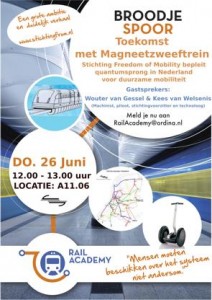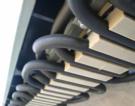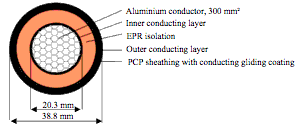Month: Wednesday July 16th, 2014
Presentation Future with Maglev train
 On invite of Ordina we gave a presention “Toekomst met Magneetzweeftrein” (Future with Maglev) for the Railacademy at June 26th, 2014. We could explain our vision and the role the maglev plays in it. We were pleased with the reactions and actively participating audience. At this place we’d like to thank the organisation and attendants.
On invite of Ordina we gave a presention “Toekomst met Magneetzweeftrein” (Future with Maglev) for the Railacademy at June 26th, 2014. We could explain our vision and the role the maglev plays in it. We were pleased with the reactions and actively participating audience. At this place we’d like to thank the organisation and attendants.
Unfortunately we couldn’t address some questions during the session. But we do that here because they might be interesting to a larger audience.
Costs, general remark
The most frequently asked questions regard costs. But in our vision costs are limited only to indicators to assess the feasibility. For actual cost we have to wait until the implementation plan is drawn up.
Otherwise cost projects will get a too large margin of error, depending on for instance spot prices of commodities (metal, concrete), land and labour. Espescially the calculated requirements of concrete constructions are important. The unit price of concrete can differ a factor 9 based on the required additives!
Fortunately, we do have such figures from previous Transrapid projects like the Zuiderzeelijn. We use these here to answer some of the questions.
Comparison investement costs infrastructure Transrapid and HSL
The explorations of the Zuiderzee route section between Lelystad and Groningen showed that the capital investment for the Transrapid infrastructure per kilometer is comparable with the construction of an HSL, namely 9.2 respectively 8.2 billion guilders, price level 2000.
([1], pag 20, table 16).
| Section | HZL-plus | ZZL-IC | ZZL-HSL | ZZL-MZB | ZZL-MZM |
|---|---|---|---|---|---|
| Schiphol-Almere | 0,6 | 0,5 | 0,6 | 4,1 | 4,1 |
| Almere-Lelystad | 0,3 | 0,3 | 0,3 | 1,3 | 1,4 |
| Lelystad-Groningen | – | 4,9 | 8,2 | 9,1 | 9,2 |
| Zwolle-Groningen/Leeuwarden | 2,0 | – | – | – | – |
| Total | 2,9 | 5,7 | 9,1 | 14,5 | 14,7 |
This section is good to compare as it fully consists of new tracks, not re-using any existing tracks. The difference is only 12%, despite the fact that the Transrapid has 2.5 x more stations, (Lelystad, Emmeloord, Heerenveen, Drachten and Groningen) over the HSL (Heerenveen, Groningen) and its dedicated energy supply costs are included ([1], pag 7, 8, 19).
Note that this concerns costs of 2001. Since then, developments such as the MMF Guideway of Professor Flessner have the potential to make Transrapid infrastructure another 30% cheaper.
Source:
- [1] PDF: Snelle verbinding tussen de Randstad en het Noorden – Resultaten van de verkenningen deel I en deel II
Ministerie van V&W, VROM, Den Haag, 15 Oktober 2001.
The original pdf has meanwhile been removed, but the relevant Parliamentary Paperk was still on line on Jul, 4th 2014.
Comparison maintenance costs Transrapid vs HSL
The Munich airport link studies provide us with cost indicators for the maintenance of the Transrapid maglev train and infrastructure in comparison to the ICE3 high speed train.
Maintenance costs per km double track of the maglev infrastructure are € 0.15 to 0.17 million per annum, well below that of the HSL with € 0.23 million per annum ([2], pag 296, 297).
Given the low-wear technology of maglev line, its 25% lower maintenance costs are no surprise. This relates to about 0.5% of the initial capital investment. For bridges in Germany this figure is 0.6%, which makes it plausible because the elevated maglev line can be regarded as a kind of continuous viaduct.
Regarding the vehicles, at comparable utilizable floor area the maintenance costs of the Transrapid maglev with € 2910/day are also well below those of the ICE3 with € 4160/day ([2], pag 297).
These 30% lower costs of maglev vehicles can be explained by the low wear due their lack of a mechanical drive train, in spite of having comparable electrical complexity to the ICE3.
Source:
- [2] Book: Transrapid und Rad-Schiene-Hochgeschwindigkeitsbahn – Ein gesamtheitlicher Systemvergleich
Prof. Dr.-Ing. Rainer Schach, Prof. Dr.-Ing. Peter Jehle, Dipl.-Ing. René Naumann
Springer-Verlag, Berlin Heidelberg, 2006, ISBN: 3-540-28334-X
Networking ability of complex switches of Transrapid?
The figures of maintenance and punctuality prove that the complex Maglev switches have no negative effect on the maintenance and reliability of the system.
The Transrapid in Shanghai is record holder in terms of availability and punctuality. Until December 2013, the vehicles have transported 40 million passengers in total with a punctuality of 99.9% over 11 million kilometers ([3], page “History 2000-now”).
The eight switches in the Shanghai route thus have proven to function well for 10 years. Hence, network formation is not a problem.
Source:
- [3] Web site: transrapid.de by Thyssenkrupp Transrapid, accessed July, 2nd 2014.
Comparison of material usage and environmental load of overhead lines versus long stator

One of the attendees had noticed the thickness of the stator cables in the Transrapid track. It was asked whether the thicker cables consume much more material than the overhead lines of conventional train. Questions were also raised about the environmental impact in using aluminum instead of copper wire.
Actually, the last two questions the easiest to answer. The Transrapid functions contactless. There is no wear of overhead wire and thus no metal disappears in the environment. During the life span of a stator cable, the overhead wires have to be replaced multiple times. And the metals from the stator cables can be fully recovered at the end of their service life. That makes the higher material usage and the type of material almost irrelevant, which is also reflected in the maintenance costs.
The long stator motor of the Transrapid contains three phase wires on either side of the track, in total 6 cables. Nexans has supplied 1000km medium voltage cable for the 30 km Transrapid track (total approx 58 km of guideway) in Shanghai ([4]). The thickness of the cable compared to conventional overhead wire is visual deception. Half of the thickness is insulating material, the conductor itself is in Shanghai 300 mm².

², a support cable of 150 mm² and a reinforcement lead of another 150 mm². Total 500 mm². ([5]). The materials for the attachment wires are not included in this figure.
The Dutch 25 kV catenary (B5 system) uses a support cable of 70 mm², a contact wire of 120 mm² copper silver, a feeder cable of 240 mm² and a equipotentiaal lead of 240 mm² aluminium ([6]). Total 670 mm², attachment wires not included.
The conductor material in the Transrapid stator cable is mainly driven by by metal prices, in principle, any conductor can be used. In Shanghai aluminium has been used. At the time of writing, aluminum is 3.8 times cheaper than copper and 25.2 times cheaper than silver ([7]).
Catenary wires must however take mechanical contact into account and therefore are made of copper or copper silver.
Hence, the investment costs for the construction of a maglev line or HST do not differ much. While, from both, only the Transrapid is designed as regular intercity for daily use of all taxpayers, instead of the 60 times smaller elite using a high speed line. Also, the new maglev infrastructure creates opportunities for the railways and airports in a way that no high speed train can provide. So easy to see where our tax money would be spent to best on… Too bad that maglev trains have no lobby.**
Sources:
- [4] Web site: Nexans.de, accessed July, 4th 2014.
- [5] Web site: wikipedia catenary, accessed July, 4th 2014.
- [6] Web site: energy supply catenary, accessed July, 4th 2014.
- [7] Web site: Metal spot prices, accessed July, 4th 2014.
- [8] Image source: Paper: New long stator winding (LSW) cable with Aero-Z conductor for high speed up with short round-trip time
Harald Buethe, Francois Daugny, Dr. Holger Fastabend, Dr. Dirk Steinbrink, Peter Zamzow,
Nexans Deutschland Industries GmbH & Co KG, Maglev Conference 2004, p7-4 Harald.Buethe.pdf
** PS: For those wanting to make a statement in support of Maglev trains, you can do so on the web site of the international maglev board, an organisation by and for experts and persons interested in Maglev trains trying to do the missing lobbying work.
